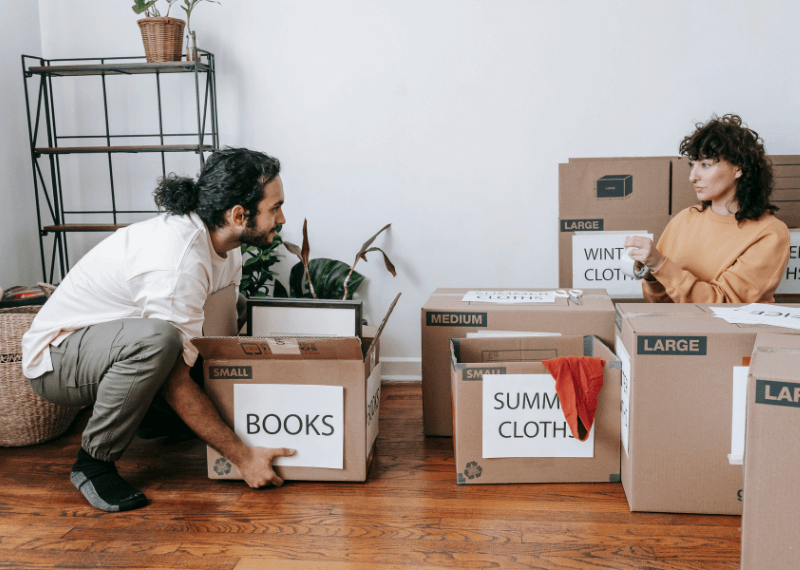Packing for a move can feel stress inducing, but with the right tips and knowledge, you can tackle it one room at a time without the sweat and tears.
A smart approach not only makes the entire move more manageable but also helps ensure that nothing gets left behind.
This room-by-room packing checklist written by a moving expert will guide you through the key steps for prepping each area of your home, so you’re ready for moving day!
Our Best Packing Tips
Before diving into room-specific packing, here are a few basic packing tips that will help you stay organized:
- Start Early: Begin packing at least 2-3 weeks before your move to avoid feeling rushed. Pack up the least used rooms and items first and start to declutter.
- Declutter: Use this time to get rid of anything you no longer need. Donate, sell, or dispose of items that won’t make the move with you. This is the best excuse to sort through your belongings.
- Label Everything: Clearly label each box with the contents and the room it belongs to. This will save you major time when unpacking.
- Quality Packing Materials: Don’t cheap out and make sure to use sturdy boxes, bubble wrap, packing paper, and enough tape to secure your home items.
- Pack by Category: Instead of packing by room alone, think about grouping similar items in the same box to make unpacking easier.
Room-by-Room Packing Help and Planning
1. Living Room
The living room has it all including furniture, electronics, books, and decor. Here’s how to approach packing this daunting space:
Furniture:
- Disassemble any furniture that can be taken apart on your own without issues Keep screws and bolts in labeled bags, taped to the furniture so you don’t lose any key parts. Inform your mover what pieces you expect them to disassemble.
- Wrap larger furniture like couches, chairs, and more in furniture pads or moving blankets to protect them from scratches or inform your mover to do so.
- Clean furniture before packing it. Wipe down surfaces from dust and dirt, because why dirty up the new home?
Electronics:
- Pack electronics like the TV and Nintendo in their original boxes if you have them. If not, use plenty of padding like bubble wrap or packing paper to keep them extra safe.
- Label cables and chargers before packing them. Tape them to the electronics they belong to.
Decor:
- Wrap artwork and mirrors in bubble wrap or towels and sheets.
- Pack fragile decor items (vases, sculptures, etc.) in small boxes with lots of padding to prevent breakage. Try using towels and sheets for extra padding.
Books:
- Books can be packed in small to medium-sized boxes, as large boxes filled with books can become too heavy to lift. Don’t over fill your cartons.
2. Kitchen: Mom’s Favorite Spot
Packing the kitchen is one of the most challenging tasks because how fraglie the items usually are and the need to use this room until moving day. Try to pack up the least used items first and leave out only a few basics until the end.
Appliances:
- Wrap all your appliances like toasters, blenders, coffee makers in their original boxes, if you kept them. If not, use bubble wrap to protect them during transit and give them their own boxes for protection.
- Defrost the freezer at least 24 hours before moving day. Clean and dry the fridge to prevent mold.
Dishes:
- Wrap plates, bowls, and glasses individually in bubble wrap to prevent breakage. Stack them carefully.
- Use dish boxes or dividers for extra protection.
- Towels, dishcloths, and yoga mats can be used as extra padding inside boxes.
Pots, Pans, and Utensils:
- This is one thing you can pack up ahead of time.
- Stack pots and pans together and wrap the handles to prevent scratches.
- Box up utensils, including knives, forks, and spoons. Keep out a few for your use.
Food:
- Use up perishable food in the days leading up to the move.
- Pack non-perishable food in boxes, but be mindful of their weight and don’t overfill boxes.
- Label any food-related items and note any expiration dates.
3. Bedroom
Pack up your humble abode but consider leaving out a sheet set for your first night in your new home.
Clothing:
- Use wardrobe boxes for hanging clothes to avoid having to rehang everything. If you don’t have wardrobe boxes, you can pack clothes in suitcases or trash bags with the hangers attached.
- Fold or roll clothing that can’t hang, and pack them into boxes.
- Shoes can be packed in shoe bags, and then placed in larger boxes or in tras.
Bedding and Linens:
- Pack bedding, towels, and linens in large bags or boxes. Consider packing a “first night” box with your essential bedding and toiletries, so you can quickly set up your bed when you arrive.
Furniture:
- Disassemble bed frames and pack any removable parts (like slats or legs) in labeled bags if you are able.
- Wrap mattresses and box springs in plastic mattress covers to protect them from dirt and damage.
Personal Items:
- Pack jewelry and makeup in small, secure boxes. Use padded pouches for delicate items that could break.
- Gather you medications and important documents in a special folder or container that you’ll carry separately with you so they don’t get lost.
4. Bathroom: The King’s Throne
The bathroom contains a lot of small items, lets learn to pack up efficiently.
Toiletries:
- Box toiletries like your shampoo, toothpaste, and soap in clear plastic bins to avoid leaks. Use Ziploc bags for liquids to prevent spills. You can always double wrap with an extra plastic bag.
- Wrap fragile items in bubble wrap and pack them carefully in a sturdy box.
Meds:
- Keep your medications in a separate bag or box and label them clearly. This will help ensure you have easy access to them during the move. It’s best to keep this in your essentials bag.
Towels and Linens:
- Pack towels in large boxes, and consider using them as extra padding for fragile items. Just don’t forget what boxes you put them all in.
- Organize bath mats, shower curtains, and toilet paper in their own box for easy access and unpacking.
5. Home Office For Remote Queens
Your home office probably has valuable electronics, files, and office supplies. Clearly label these boxes so you can get your new office up and running asap.
Electronics:
- Pack computers, printers, and screens in boxes that fit well with plenty of padding if you don’t have the original boxes.
- Label cables and chargers, and keep them organized in a zip-lock bag or small box. Tape them to the places they should be.
- Group office supplies (pens, notebooks, binders) into smaller boxes or bins for easy transport.
6. Garage and Storage
The garage and storage or basement has those large and heavy items, like tools, sporting goods, and random finds. Let’s figure out how to pack up. This is usually a great place to begin packing first.
Tools:
- Pack tools in sturdy boxes, and secure sharp objects like saws and scissors in padded holders for safety.
- Use plastic bins for smaller items like screws, nails, and bolts, and clearly label what’s inside.
Sports Things:
- Wrap delicate equipment in blankets or bubble wrap to prevent damage during transit. Use proper cases where needed.
- Use large boxes for things like camping gear, fishing rods, or sports balls. Keep things grouped together for logic.
Frequently Asked Questions
How do I protect my fragile items while packing?
Use bubble wrap, packing paper, or extra towels and blankets to cushion fragile items. Make sure they are well-padded on all sides and packed securely in boxes that are appropriately sized. Don’t over stuff any boxes to keep things safe.
How do I pack up my clothes for a move?
Use wardrobe boxes for hanging clothes or pack folded clothes in suitcases or large boxes. Rolling clothes can save space and prevent wrinkles. Keep closets together as they were in the old home for simplicity.
What’s the best way to pack books for a move?
Books should be packed in small to medium-sized boxes to avoid making the boxes too heavy. Be sure to pack them flat and don’t overfill the boxes or they will get too heavy.
Should I pack food for the move?
Only pack non-perishable food the rest you should toss. Canned goods, dry foods, and spices are safe to move. For perishables, finish them up before the move or donate them to needy people.
How early should I start packing for a move?
It’s a good idea to start packing at least 2-3 weeks before your move date. Even earlier if you can finish up the garage. Begin with non-essential items like books, decor, and seasonal things, and work your way to daily-use items closer to the moving day.




